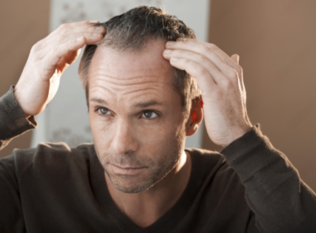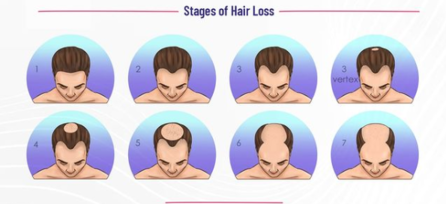Male pattern baldness is a common condition that occurs by the gradual hair loss in men. Balding often starts with gradual thinning and receding of the hairline, forming an “M” shape. A receding hairline and crown thinning are the first signs of male pattern baldness, which normally follows a predictable pattern.
Fortunately, there are a number of therapies available to control and enhance the appearance of male pattern baldness, including drugs, topical remedies, and surgical procedures.

7 Stages of Balding

Male pattern baldness normally develops in stages. Here is an outline of each stage:
Stage 1: There is no noticeable hair loss or hairline recession. The hairline remains at its normal position without any signs of balding.
Stage 2: In this stage, there is a small recession of the hairline at the temples (between ears and forehead), and hair loss is visible. This usually curves into a shallow “M” shape, indicating the start of hair loss.
Stage 3: Hair loss progresses further in this stage. The “M” form is more clearly defined when the recession at the temples deepens. Additionally, hair near the vertex (top) of the scalp may begin to thin.
Stage 4: Stage 4 is marked by a more pronounced “M”-shaped hairline recession and significant crown hair loss. The bald areas at the temples and vertex become more noticeable.
Stage 5: In stage 5, the balding spots in the crown and temples keep growing. The remaining hair forms a thin bridge between the two areas of hair loss.
Stage 6: The hairline between the crown and temples gets narrower in stage 6. The hair loss at the temples and crown progresses further, and the bald areas may start to merge.
Stage 7: Stage 7 is the most advanced stage of male pattern baldness. Only a thin band of hair remains on the sides and back of the head, while the top of the scalp experiences severe balding.
Causes
Genetic Factors: Genetics is the main cause of balding. You are more likely to experience hair loss if you have a family history of baldness, especially in your parents or grandparents.
Hormonal Factors: Male pattern baldness is significantly influenced by hormones. A hormone called DHT is responsible for reducing the size of hair follicles and shortening their growth cycle. In individuals with genetic susceptibility, hair follicles become more sensitive to DHT, leading to the gradual shrinking of hair follicles and thinning of the hair.
Age and Hormonal Changes: Male pattern baldness is often related to aging. The amount of DHT and testosterone may change as men age, resulting in more hair follicle thinning.
Other Factors: While genetics and hormones are the primary causes, other factors can contribute to male pattern baldness or accelerate its effects. These include certain medical conditions such as thyroid and autoimmune diseases and lifestyle factors such as poor nutrition, smoking, and excessive stress.
Symptoms of male pattern baldness
Receding Hairline
Thinning Crown
Increased Hair Shedding
Thinning Hair
The emotional impact of Male Pattern Baldness
Male pattern baldness can deeply affect individuals on a psychological and emotional level. It often leads to decreased self-esteem, body image concerns, and social anxiety.
Emotional distress, such as sadness and embarrassment, can arise from the changes in appearance. To address the impact of male pattern baldness you can seek treatments or hair restoration options to enhance your appearance and regain confidence.
Male Pattern Baldness Treatment
There are numerous treatment options for male pattern baldness. The choice of treatment depends on various factors such as the stage of hair loss, personal preferences, and the recommendations of hair specialists. Here are some common treatment options:
Medications
Few medications such as Minoxidil can be applied directly to the scalp. There are a few medicines that can be taken orally as well. This prevents the production of DHT, the hormone responsible for shrinking hair follicles. Both help in slowing down hair loss and encourage hair growth.
Low-Level Laser Therapy (LLLT)
In order to promote hair growth, LLLT involves the use of tools like laser combs or caps that produce low-power lasers or light-emitting diodes (LEDs). It is believed to encourage thicker, healthier hair by increasing blood flow to the hair follicles.
Hair Transplantation
Hair follicles from donor parts of the scalp that have dense hair growth are removed and placed in areas of the scalp that have thinning or balding hair during the hair transplant surgery. This method can produce long-lasting, natural-looking results and is appropriate for people with more advanced hair loss.
Scalp Micropigmentation (SMP)
Scalp Micropigmentation is a non-invasive cosmetic treatment that involves tattooing tiny, pigmented dots on the scalp to create the illusion of a closely shaved head or thicker hair density. It can be applied to hide bald patches or provide the appearance of a shaved head.
Lifestyle modifications that can prevent hair loss
While lifestyle modifications cannot completely prevent or reverse male pattern baldness, they may help slow down its progression. Here are some lifestyle modifications that can support hair health and minimize hair loss:
Follow a Nutritious Diet: Consuming a balanced diet rich in vitamins, minerals, and proteins. Prepare a diet that is rich in a variety of fruits and vegetables, whole grains, lean meats, and healthy fats.
Maintain a Healthy Weight: Obesity and excessive weight gain have been associated with an increased risk of hair loss. You may maintain a healthy weight by eating a balanced diet and exercising on a regular basis.
Be Gentle with Your Hair: Avoid harsh hair care techniques that could harm hair follicles and cause hair loss. Opt for gentle hair care products and minimize heat styling tools.
Manage Stress: High levels of stress can lead to hair loss. Incorporate stress management techniques into your routine, such as exercise, meditation, yoga, or engaging in hobbies and activities that help you relax and unwind.
Frequently Asked Questions
How common is male pattern baldness?
Male pattern baldness is prevalent, particularly as men age. It is estimated that approximately 50% of men will experience some degree of male pattern baldness by the age of 50. Some men may experience minimal hair loss, while others may have more extensive balding.
Can diet and nutrition impact hair health and hair loss?
Yes, diet and nutrition can impact hair health and hair loss. A balanced and nutrient-rich diet plays a crucial role in the growth and maintenance of healthy hair.
What are the early signs of male pattern baldness?
The early signs of male pattern baldness include Receding Hairline, Thinning Hair, and Increased Hair Shedding.
Is hair transplant surgery a viable option for male pattern baldness?
Yes, hair transplant surgery is a viable and effective option for treating male pattern baldness, particularly for individuals with more advanced hair loss. It is considered one of the successful solutions for restoring hair.
Can stress contribute to male pattern baldness?
Yes, stress can contribute to male pattern baldness, but it is not the primary cause. Male pattern baldness is primarily driven by genetic and hormonal factors, specifically the sensitivity of hair follicles to dihydrotestosterone (DHT).
Does wearing hats or caps cause hair loss?
No, wearing hats or caps does not directly cause permanent hair loss or male pattern baldness. The common belief that wearing hats leads to hair loss is a myth.
